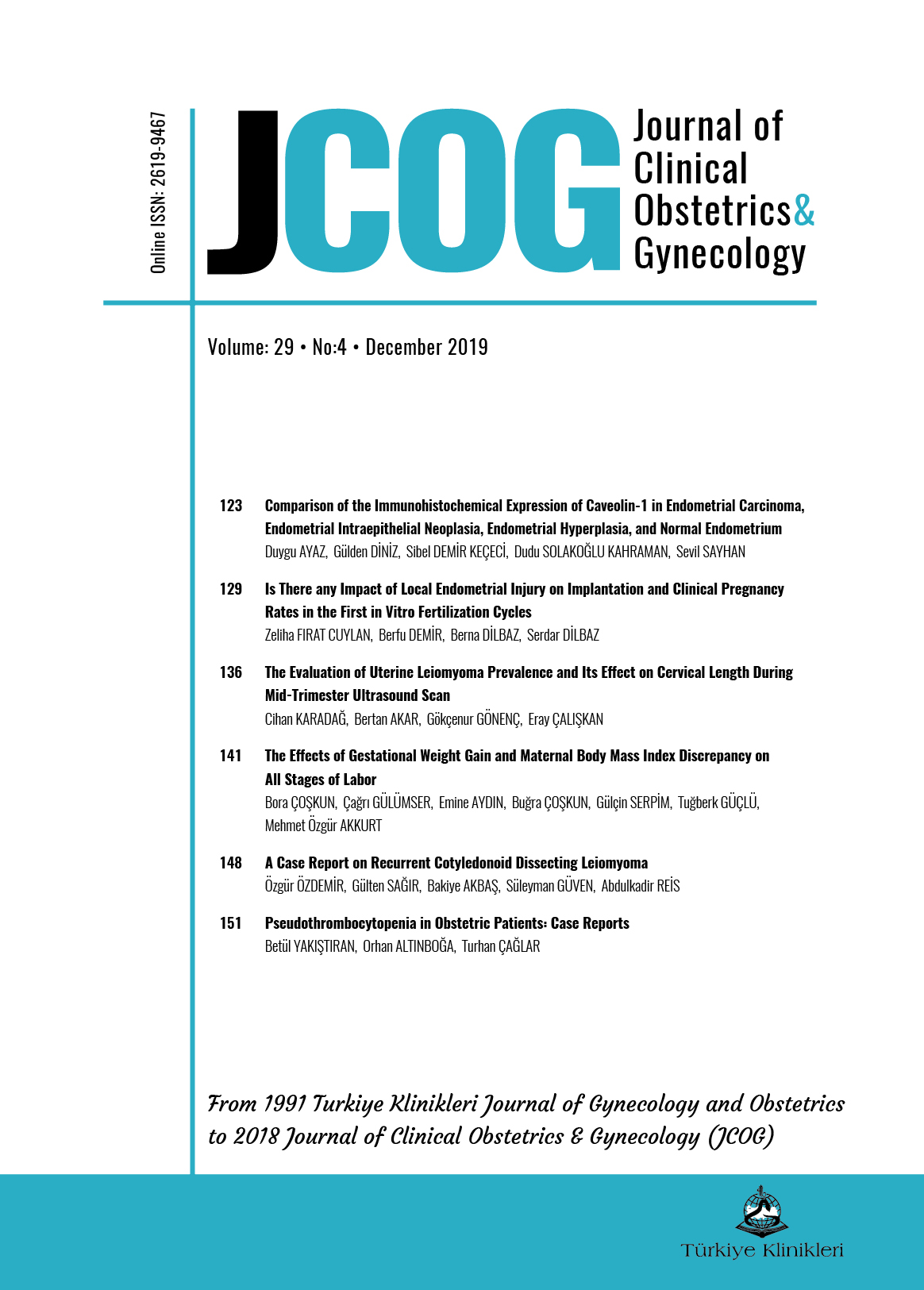Open Access
Peer Reviewed
ORIGINAL RESEARCH
2810 Viewed1143 Downloaded
The Evaluation of Uterine Leiomyoma Prevalence and Its Effect on Cervical Length During Mid-Trimester Ultrasound Scan
Received: 04 Sep 2019 | Received in revised form: 27 Oct 2019
Accepted: 08 Nov 2019 | Available online: 29 Nov 2019
J Clin Obstet Gynecol. 2019;29(4):136-40
DOI: 10.5336/jcog.2019-71319
Article Language: EN
Article Language: EN
Copyright Ⓒ 2025 by Türkiye Klinikleri. This is an open access article under the CC BY-NC-ND license (http://creativecommons.org/licenses/by-nc-nd/4.0/)
ABSTRACT
Objective: This study aims to investigate the effects of uterine leiomyomas' on cervical length in pregnant women during mid-trimester ultrasound scan. Material and Methods: In this study, 1908 pregnant women aged 18-44 years were evaluated via abdominal and transvaginal ultrasounds in the mid-trimester (18-24 weeks). The number, size, type and location of the leiomyomas were screened and recorded. Cervical length was measured transvaginally on an empty bladder. Short cervix was defined as lower than 25 mm. Pregnant women with leiomyoma were compared with pregnant women without leiomyoma regarding cervical length and short cervix incidence. Results: Eighty (4.2%) patients were diagnosed with uterine leiomyoma and the mean diameter of uterine leiomyomas was 31.4 mm. The mean cervical length of the leiomyoma group was significantly lesser than that in pregnant women without leiomyomas (p=0.001). The number of women with a short cervix was higher in the leiomyoma group than the controls (p=0.001). There was a significant positive correlation between age and leiomyoma prevalence (r=0.294, p=0.021). There was a significant negative correlation between myoma size and cervical length in women with only one leiomyoma (r=-0.325, p=0.015). Conclusion: Pregnant women with leiomyoma have higher incidence of short cervix. Leiomyomas could negatively affect cervical length.
Objective: This study aims to investigate the effects of uterine leiomyomas' on cervical length in pregnant women during mid-trimester ultrasound scan. Material and Methods: In this study, 1908 pregnant women aged 18-44 years were evaluated via abdominal and transvaginal ultrasounds in the mid-trimester (18-24 weeks). The number, size, type and location of the leiomyomas were screened and recorded. Cervical length was measured transvaginally on an empty bladder. Short cervix was defined as lower than 25 mm. Pregnant women with leiomyoma were compared with pregnant women without leiomyoma regarding cervical length and short cervix incidence. Results: Eighty (4.2%) patients were diagnosed with uterine leiomyoma and the mean diameter of uterine leiomyomas was 31.4 mm. The mean cervical length of the leiomyoma group was significantly lesser than that in pregnant women without leiomyomas (p=0.001). The number of women with a short cervix was higher in the leiomyoma group than the controls (p=0.001). There was a significant positive correlation between age and leiomyoma prevalence (r=0.294, p=0.021). There was a significant negative correlation between myoma size and cervical length in women with only one leiomyoma (r=-0.325, p=0.015). Conclusion: Pregnant women with leiomyoma have higher incidence of short cervix. Leiomyomas could negatively affect cervical length.
REFERENCES:
- Okolo S. Incidence, aetiology and epidemiology of uterine fibroids. Best Pract Res Clin Obstet Gynaecol. 2008;22(4):571-88. [Crossref] [PubMed]
- Stout MJ, Odibo AO, Graseck AS, Macones GA, Crane JP, Cahill AG. Leiomyomas at routine second-trimester ultrasound examination and adverse obstetric outcomes. Obstet Gynecol. 2010;116(5):1056-63. [Crossref] [PubMed]
- Laughlin SK, Baird DD, Savitz DA, Herring AH, Hartmann KE. Prevalence of uterine leiomyomas in the first trimester of pregnancy: an ultrasound screening study. Obstet Gynecol. 2009;113(3):630-5. [Crossref] [PubMed] [PMC]
- De Vivo A, Mancuso A, Giacobbe A, Savast LM, De Dominici R, Dugo N, et al. Uterine myomas during pregnancy: a longitudinal sonographic study. Ultrasound Obstet Gynecol. 2011;37(3):361-5. [Crossref] [PubMed]
- Coronado GD, Marshall LM, Schwartz SM. Complications in pregnancy, labor, and delivery with uterine leiomyomas: a population-based study. Obstet Gynecol. 2000;95(5):764-9. [Crossref] [PubMed]
- Lee HJ, Norwitz ER, Shaw J. Contemporary management of fibroids in pregnancy. Rev Obstet Gynecol. 2010;3(1):20-7. [PubMed]
- Chen YH, Lin HC, Chen SF, Lin HC. Increased risk of preterm births among women with uterine leiomyoma: a nationwide population-based study. Hum Reprod. 2009;24(12):3049-56. [Crossref] [PubMed]
- Shavell VI, Thakur M, Sawant A, Kruger ML, Jones TB, Singh M, et al. Adverse obstetric outcomes associated with sonographically identified large uterine fibroids. Fertil Steril. 2012;97(1):107-10. [Crossref] [PubMed]
- Qidwai GI, Caughey AB, Jacoby AF. Obstetric outcomes in women with sonographically identified uterine leiomyomata. Obstet Gynecol. 2006;107(2 Pt 1):376-82. [Crossref] [PubMed]
- Vergani P, Ghidini A, Strobelt N, Roncaglia N, Locatelli A, Lapinski RH, et al. Do uterine leiomyomas influence pregnancy outcome? Am J Perinatol. 1994;11(5):356-8. [Crossref] [PubMed]
- Vergani P, Locatelli A, Ghidini A, Andreani M, Sala F, Pezzullo JC. Large uterine leiomyomata and risk of cesarean delivery. Obstet Gynecol. 2007;109(2 Pt 1):410-4. [Crossref] [PubMed]
- Roberts WE, Fulp KS, Morrison JC, Martin JN Jr. The impact of leiomyomas on pregnancy. Aust N Z J Obstet Gynaecol. 1999;39(1):43-7. [Crossref] [PubMed]
- Goldenberg RL, Iams JD, Miodovnik M, Van Dorsten JP, Thurnau G, Bottoms S, et al. The preterm prediction study: risk factors in twin gestations. Am J Obstet Gynecol. 1996;175(4 Pt 1):1047-53. [Crossref] [PubMed]
- Berghella V, Roman A, Daskalakis C, Ness A, Baxter JK. Gestational age at cervical length measurement and incidence of preterm birth. Obstet Gynecol. 2007;110(2 Pt 1):311-7. [Crossref] [PubMed]
- Bałoniak B, Słomko Z, Malewski Z, Drews K. [The incidence of uterine leiomyomas in pregnancy and their influence upon its course]. Ginekol Pol. 2002;73(4):260-5. [PubMed]
- Cooper NP, Okolo S. Fibroids in pregnancy--common but poorly understood. Obstet Gynecol Surv. 2005;60(2):132-8. [Crossref] [PubMed]
- Marshall LM, Spiegelman D, Barbieri RL, Goldman MB, Manson JE, Colditz GA, et al. Variation in the incidence of uterine leiomyoma among premenopausal women by age and race. Obstet Gynecol. 1997;90(6):967-73. [Crossref] [PubMed]
- Blitz MJ, Rochelson B, Augustine S, Greenberg M, Sison CP, Vohra N. Uterine fibroids at routine second-trimester ultrasound survey and risk of sonographic short cervix. J Matern Fetal Neonatal Med. 2016;29(21):3454-60. [PubMed]
MENU
POPULAR ARTICLES
MOST DOWNLOADED ARTICLES





This journal is licensed under a Creative Commons Attribution-NonCommercial-NoDerivatives 4.0 International License.










